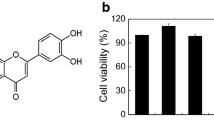Abstract
Purpose. The purpose of the present study was to examine the pharma-codynamic and pharmacokinetic features of the novel mast cell inhibitor 4-(3′-Hydroxyphenyl)-amino-6,7-dimethoxyquinazoline (WHI-P180) in mice.
Methods. A high performance liquid chromatography (HPLC)-based quantitative detection method was used to measure plasma WHI-P180 levels in mice. The plasma concentration-time data was fit to a single compartment pharmacokinetic model by using the WinNonlin program to calculate the pharmacokinetic parameters. A cutaneous anaphylaxis model was used to examine the pharmacodynamic effects of WHI-P180 on anaphylaxis-associated vascular hyperpermeability.
Results. The elimination half-life of WHI-P180 in CD-1 mice (BALB/ c mice) following i.v., i.p., or p.o. administration was less than 10 min. Systemic clearance of WHI-P180 was 6742 mL/h/kg in CD-1 mice and 8188 mL/h/kg in BALB/c mice. Notably, WHI-P180, when administered in two consecutive nontoxic i.p. bolus doses of 25 mg/kg, inhibited IgE/antigen-induced vascular hyperpermeability in a well-characterized murine model of passive cutaneous anaphylaxis.
Conclusions. WHI-P180 is an active inhibitor of IgE-mediated mast cell responses in vitro and in vivo. Further preclinical characterization of WHI-P180 may improve the efficacy of WHI-P180 in vivo and provide the basis for design of effective treatment and prevention programs for mast cell mediated allergic reactions.
Similar content being viewed by others
REFERENCES
M. J. Hamawy, S. E. Mergenhagen, and R. P. Siraganian. Protein tyrosine phosphorylation as a mechanism of signalling in mast cells and basophils. Cellular Signalling 7:535–544 (1995).
A. M. Scharenberg and J-P. Kinet. Early events in mast cell signal transduction. Chem. Immunol. 61:72–87 (1995).
S. J. Galli. New concept about the mast cell. N. Eng. J. Med. 328:257–263 (1993).
S. J. Galli, J. R. Gordon, and B. K. Wershil. Cytokine production by mast cells and basophils. Curr. Opin. Immunol. 3:865–872 (1991).
R.-K. Narla, X-P, Liu, D. E. Myers, and F. M. Uckun. 4-(3′-Bromo-4′ hydroxylphenyl)-amino-6,7-dimethoxyquinazoline (WHI-P154): A novel quinazoline derivative with potent cytotoxic activity against human glioblastoma cells. Clin. Cancer Res. 4:1405–1414 (1998).
R. K. Narla, X-P, Liu, D. Klis, and F. M. Uckun. Inhibition of Human Glioblastoma Cell Adhesion and Invasion by 4-(4′-Hydroxylphenyl)-Amino-6,7-Dimethoxyquinazoline (WHI-P131) and 4-(3′-Bromo-4′-Hydroxylphenyl)-Amino-6,7-Dimethoxyquinazoline (WHI-P154). Clin. Cancer Res. 4:2463–2471 (1998).
K. Ozawa, Z. Szallasi, M. G. Kazanietz, P. M. Blumberg, H. Miscjak, J. F. Mushinski, and M. A. Beaven. Ca2+-dependent and Ca2+-independent isozymes of protein kinase C mediate exocytosis in antigen-stimulated rat basophilic RBL-2H3 cells. Reconstitution of secretory responses with Ca2+ and purified isozymes in washed permeabililized cells. J. Biol. Chem. 268:1749–1756 (1993).
R. Malaviya, R. Malaviya, and B. A. Jakschik. Reversible translocation of 5-lipoxygenase in mast cells upon IgE/antigen stimulation. J. Biol. Chem. 268:4939–4449 (1993).
C. L. Chen, R. K. Narla, X. P. Liu, and F. M. Uckun. A quantitative HPLC detection method for WHI-P154 [4-(3′-bromo-4′hydroxylphenyl)-amino-6,7-dimethoxyquinazoline]. J. Liquid Chromatogr. & Related Technologies. In press, 1998.
User's Guide, WinNonlin, Scientific Consulting, Inc., Cary, NC, 1995.
I. Miyajima, D. Dombrowicz, T. R. Martin, J. V. Ravetch, J.-P. Kinet, and S. J. Galli, Systemic anaphylaxis in the mouse can be mediated largely through IgG1 and Fc gammaRIII. Assessment of the cardiopulmonary changes, mast cell degranulation, and death associated with active or IgE-or IgG1-dependent passive anaphylaxis. J. Clin. Invest. 99:901–914 (1997).
C. L. Chen, S. Sangiah, J. D. Roder, H. Chen, K. D. Berlin, G. L. Garrison, B. J. Scherlag, and R. Lazzara. Pharmacokinetics and plasma protein binding of the new potent class III antiarrythmic agent 3-[4-(1H-immidazol-1yl)benzoyl]-7-isopropyl-3,7-diazabicyclo[3.3.1]nonane dihydroperchlorate. Arzneimittel-Forschung/Drug Research 45:670–675 (1995).
J. Oravcova, B. Bohs, and W. Lindner. Drug-protein binding studies: New trend in analytical and experimental methodology. J. Chromatogr. B 677:1–28 (1996).
B. Davies and T. Morris. Physiological parameters in laboratory animals and humans. Pharm. Res. 10:1093–1095 (1993).
H. C. Oettgen, T. R. Martin, A. Wynshaw-Boris, C. Deng, J. M. Drazen, and P. Leder. Active anaphylaxis in IgE-deficient mice. Nature 370:367–370 (1994).
W. G. Spector and D. A. Willoughby. Vasoactive amines in acute inflammation. Ann. N.Y. Acad. Sci. 116:839–846 (1964).
B. F. Ramos, Y. Zhang, V. Angkachatchai, and B. A. Jakschik. Mast cell mediators regulate vascular permeability changes in Arthus reactions. J. Pharm. Exp. Ther. 262:559–565 (1992).
Y. Zhang, B. F. Ramos, and B. A. Jakschik. Augmentation of reverse Arthus reaction by mast cells in mice. J. Clin. Invest. 88:841–846 (1991).
D. J. Jodrell, D. R. Newell, W. Gibson, L. R. Hughes, and A. H. Calvert. The pharmacokinetics of the quinazoline antifolate ICI D1694 in mice and rats. Cancer Chemother. Pharmacol. 28:331–338 (1991).
Author information
Authors and Affiliations
Rights and permissions
About this article
Cite this article
Chen, CL., Malaviya, R., Navara, C. et al. Pharmacokinetics and Biologic Activity of the Novel Mast Cell Inhibitor, 4-(3′-Hydroxyphenyl)-amino-6,7-dimethoxyquinazoline in Mice. Pharm Res 16, 117–122 (1999). https://doi.org/10.1023/A:1018835232027
Issue Date:
DOI: https://doi.org/10.1023/A:1018835232027




